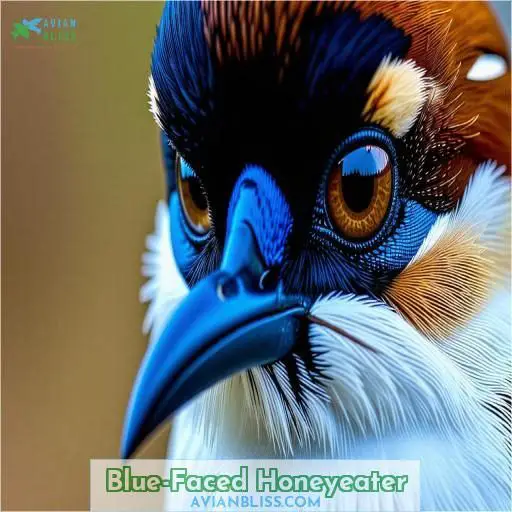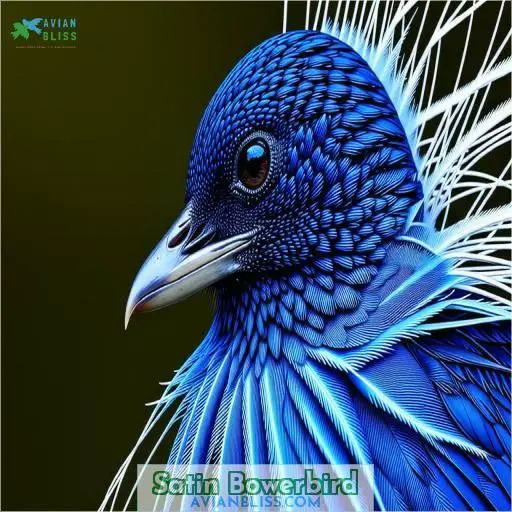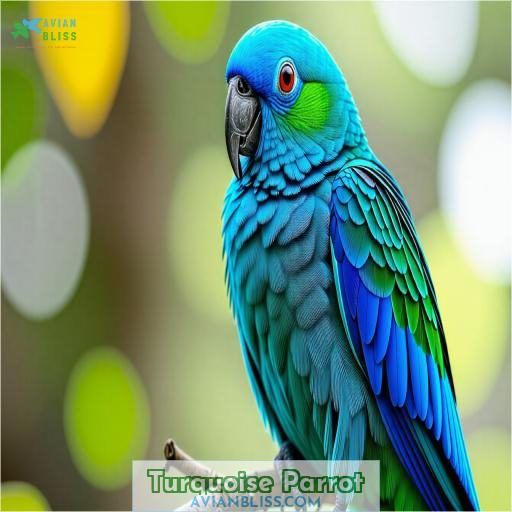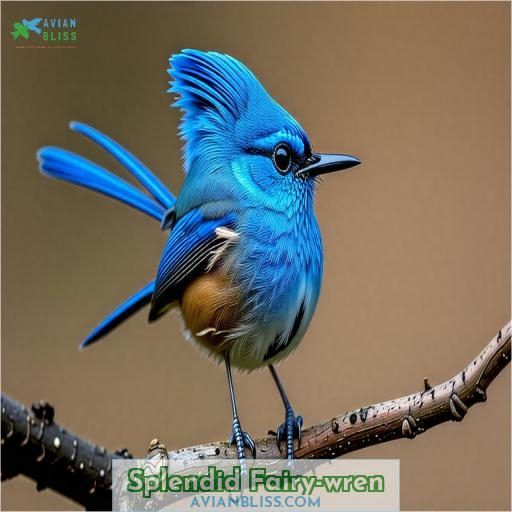This site is supported by our readers. We may earn a commission, at no cost to you, if you purchase through links.
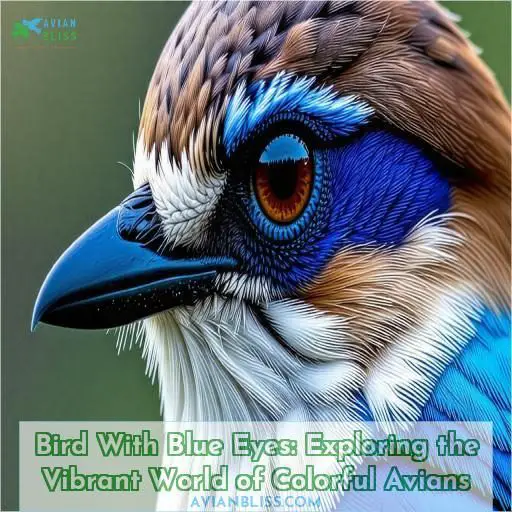
You might spot the Satin Bowerbird, endemic to Australia and New Guinea, with its striking blue peepers.
Or perhaps the Turquoise Parrot, found in the eucalyptus forests of eastern Australia, will catch your eye with its brilliant blue eye-ring.
These feathered beauties are not only visually stunning but also fascinating in their behaviors.
From the Bowerbird’s intricate mating rituals to the Turquoise Parrot’s cooperative breeding.
Immerse yourself in the captivating world of these colorful avians to uncover their secrets.
Table Of Contents
- Key Takeaways
- Blue-Faced Honeyeater
- Satin Bowerbird
- Varied Sittella
- Turquoise Parrot
- Splendid Fairy-wren
- Frequently Asked Questions (FAQs)
- Are there any birds with blue eyes?
- What is the blue eyes bird called?
- What is a gray bird with blue around its eyes?
- What kind of bird has a blue outline around its eyes?
- What adaptations allow birds to have blue eyes?
- How do blue eyes help birds survive in their habitats?
- Are there any endangered bird species with blue eyes?
- Can birds see color in the same way humans do?
- Are there any cultural or symbolic meanings associated with blue-eyed birds?
- Conclusion
Key Takeaways
- Birds with striking blue eyes, like the satin bowerbird and turquoise parrot, are found in Australia and New Guinea.
- The blue-faced honeyeater, a large honeyeater species, has distinctive blue skin around its eyes and a diverse diet of insects, nectar, and fruit.
- The satin bowerbird constructs intricate mating grounds called bowers, decorated with blue objects to attract potential mates.
- The varied sittella, a small tree-creeper with a blue eye-ring, feeds primarily on insects and spiders gleaned from the bark and foliage of trees in eastern Australia’s eucalyptus forests.
Blue-Faced Honeyeater
You’ll encounter the distinctive blue-faced honeyeater, a large honeyeater species found in northern and eastern Australia, as well as Papua New Guinea. This unique bird possesses striking blue skin around its eyes, and its diet consists of insects, nectar, and fruit.
Large Honeyeater With Distinctive Blue Skin Around Eyes
The Blue-faced Honeyeater, with its distinctive blue skin adaptation around the eyes, is a large honeyeater species found in northern and eastern Australia, as well as Papua New Guinea.
This species is known for its diverse feeding behavior, cooperative breeding tendencies, and its ability to thrive in a broad habitat diversity.
The geographic range of the Blue-faced Honeyeater encompasses various tropical, subtropical, wetter temperate, and semi-arid zones.
Found in Northern and Eastern Australia, Papua New Guinea
The blue-faced honeyeater, a striking bird with olive upperparts, white underparts, and a black head and throat, is found in northern and eastern Australia, as well as southern Papua New Guinea. Its distinctive blue eye patches make it easily recognizable. This large honeyeater is a common sight in open woodlands, parks, and gardens across its wide distribution range (Source).
Feeds on Insects, Nectar, and Fruit
The blue-faced honeyeater’s diverse diet includes insects, nectar, and fruit.
They forage in pairs or noisy flocks, excluding other birds from their feeding area while sometimes associating with species like yellow-throated miners.
These large honeyeaters prefer cup-shaped nectar sources and cultivated crops like bananas.
Their varied calls and cooperative breeding with immature birds help them thrive in their northern Australian habitat.
Satin Bowerbird
Let’s explore the striking satin bowerbird, a fascinating endemic species of Australia and New Guinea. Mature males of this species sport vibrant blue eyes and construct intricate mating grounds called bowers, decorated with blue objects to attract potential mates.
Endemic to Australia and New Guinea
The blue-faced honeyeater is endemic to Australia and southern New Guinea, thriving in open forests and woodlands. Its striking blue facial skin, white nape and cheeks, and golden olive-green plumage help it blend into its habitat. This adaptable species plays a essential role in its ecosystem, pollinating plants and controlling insect populations .
Mature Males Have Bright Blue Eyes
Mature male satin bowerbirds flaunt their bright blue eyes, a striking contrast to their black plumage.
These vibrant eyes play a pivotal role in courtship, signaling dominance and attracting females.
The birds’ diet varies, including fruits, flowers, and insects, providing the necessary nutrients for their eye-catching appearance.
Their habitat preferences and social dynamics revolve around their unique breeding habits and territorial behavior.
Builds Intricate Mating Grounds Called Bowers
The Satin Bowerbird, renowned for its exquisite bower construction and decoration, carefully crafts intricate mating grounds to attract potential mates.
These bowers, adorned with various objects including blue treasures, play a core role in mate selection and courtship displays.
Such elaborate displays highlight the bird’s dedication to impressing females, showcasing the importance of bower quality in the intricate world of satin bowerbirds.
Varied Sittella
Among the diverse species that adorn the eucalyptus forests of eastern Australia, the varied sittella stands out with its striking blue eye-ring, a distinctive feature that complements its drab plumage. Feeding primarily on insects and spiders gleaned from the bark and foliage of trees, this small tree-creeper exhibits unique foraging behaviors adapted to its arboreal lifestyle.
Small Tree-creeper With Blue Eye-ring
The varied sittella, a small tree-creeper with a striking blue eye-ring, is a delightful addition to the vibrant world of birds with blue eyes. These social birds prefer eucalyptus forests in eastern Australia, where they forage in pairs or small groups, feeding on insects and spiders. Their breeding patterns involve nesting in tree hollows, showcasing their adaptability to their habitat.
Found in Eucalyptus Forests of Eastern Australia
The varied sittella, a small tree-creeper with a distinctive blue eye-ring, makes its home in the eucalyptus forests of eastern Australia. Its striking appearance features a white crown, black face, and white underparts. This species is divided into two subspecies, each with slight variations in plumage and distribution across its southern range.
Feeds on Insects and Spiders
The Varied Sittella has diverse feeding habits, including a preference for insects and spiders. These birds are known to form small flocks and show unique feeding behavior by hunting for spiders and consuming insects, nectar, and fruit. Their light grey underparts and distinctive grey-black throat and upper breast set them apart, indicating their varied diet. Varied Sittellas are also observed to inhabit babbler nests while exhibiting social behaviors (Source).
| Feeding Preferences | Feeding Habits |
|---|---|
| Insects and spiders | Hunting behavior |
| Nectar sources | Fruit consumption |
Turquoise Parrot
You’ll encounter the turquoise parrot, a small bird native to eastern Australia with a distinctive blue eye-ring. This vibrant parrot feeds primarily on seeds, fruits, and insects found in its woodland and forest habitats.
Small Parrot With Blue Eye-ring
The turquoise parrot, a small but vibrant member of the parrot family, is easily recognized by its striking blue eye-ring.
Found in eastern Australia, these social birds thrive in a variety of habitats, from open woodlands to grasslands.
They feed on a diverse diet of seeds, fruits, and insects, often foraging in small flocks alongside other species like yellow-throated miners and noisy miners.
Found in Eastern Australia
The turquoise parrot, a vibrant gem of eastern Australia’s forests, flutters amidst the lush canopy.
Its striking blue eye-ring, a distinctive feature, helps it navigate the dappled light of its rainforest home.
This cooperative breeder thrives in the open woodlands and tropical areas of the eastern mainland, its range extending into southern New Guinea.
Its blue hues blend seamlessly with the verdant foliage, a testimony to nature’s artistry.
Feeds on Seeds, Fruits, and Insects
The Turquoise Parrot, found in Eastern Australia, primarily feeds on seeds, fruits, and insects. It shows a preference for nectar sources such as flowers of the Darwin woollybutt and Darwin stringybark, while its insect preferences encompass cockroaches, termites, grasshoppers, beetles, ants, and spiders. With a patchy distribution, this social bird forms extended family groups and exhibits cooperative breeding strategies. (Source)
Splendid Fairy-wren
The splendid fairy-wren is a small passerine bird native to southern Australia, easily recognizable by its vibrant blue facial plumage and throat. These colorful wrens inhabit heathlands, shrublands, and woodlands across the southern regions of the continent, often observed hopping and foraging on or near the ground.
Small Wren With Bright Blue Face and Throat
The splendid fairy-wren is an alluring small wren with a vibrant blue face and throat. Its olive green back, white nape, and black head create a striking contrast, while its sturdy bill is perfect for foraging. This colorful avian is a true delight to observe in its natural habitat, showcasing the beauty of Australia’s diverse birdlife.
Found in Southern Australia
The splendid fairy-wren, found across southern Australia from South Australia to southern Queensland, is a vibrant blue bird with a striking face.
These small wrens are locally nomadic, making regular seasonal movements in search of food and shelter.
With their cheerful songs and energetic hops, splendid fairy-wrens bring a touch of azure beauty to the woodlands and scrublands they call home.
Frequently Asked Questions (FAQs)
Are there any birds with blue eyes?
Yes, there are birds with beautiful blue eyes! The black-and-red broadbill, satin bowerbird, and green pigeons are a few species blessed with striking blue or purple peepers that help them attract mates and evade predators.
What is the blue eyes bird called?
The bird known for its striking blue eye markings is the yellow-tinted honeyeater, scientifically named Entomyzon cyanotis. Its vivid blue facial patches encircle piercing yellow eyes, a distinctive trait setting it apart.
What is a gray bird with blue around its eyes?
You’re likely seeing a blue-faced honeyeater, a large black, white, and olive-green bird with striking blue skin around its eyes.
What kind of bird has a blue outline around its eyes?
You’re looking at the yellow-tinted honeyeater, a striking Australian bird with a black head ringed by vivid blue skin around its eyes.
What adaptations allow birds to have blue eyes?
Imagine gazing into the striking blue eyes of a bird! These vibrant hues result from unique structural patterns that refract and scatter light, creating mesmerizing iridescence designed to attract mates and deter predators.
How do blue eyes help birds survive in their habitats?
You’ll find blue eyes enhance birds’ visual acuity, aiding UV detection vital for foraging and communicating. They also attract mates through striking appearances. Fundamentally, blue peepers boost survival chances in many habitats.
Are there any endangered bird species with blue eyes?
Yes, the Guam Micronesian kingfisher has striking blue eyes around a black mask. This vibrant forest bird is critically endangered due to habitat loss and introduced predators like the brown tree snake.
Can birds see color in the same way humans do?
To cut to the chase, birds perceive color differently than humans. Their vision is adapted for specific needs like navigation and mate selection.
Are there any cultural or symbolic meanings associated with blue-eyed birds?
Yes, in many cultures, blue-eyed birds symbolize spiritual vision, truth, and enlightenment. Their mesmerizing gaze awakens wonder at nature’s beauty.
Conclusion
Envision a world where the sky’s hue reflects in the eyes of its feathered inhabitants—birds with blue eyes.
These vibrant avians, from honeyeaters to parrots, offer a glimpse into nature’s enchanting palette.
As you explore their habitats and behaviors, let their brilliant peepers ignite your curiosity, reminding you that beauty often resides in the most unexpected corners of our world.

